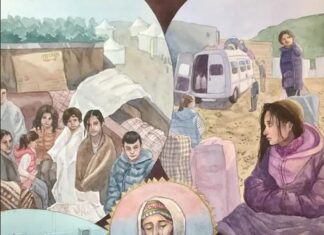By Aram Arkun
Mirror-Spectator Staff
NEW YORK — Despite all the dramatic events at the turn of the last century — the Armenian earthquake, the independence of the Armenian Republic and the Karabagh struggle — the Armenian Genocide still sits squarely at the center of attention of most Armenian- Americans. A new play by Sevan Kaloustian Greene shows once more that its impact continues to be felt culturally and artistically. “Forgotten Bread,” directed by Johanna McKeon, premiered off- Broadway in a staged reading on September 13, at the 4th Street Theatre here. It was the first performance in a monthly series called “Highlight: Shedding Light on the Talents of Theatre Artists of Middle Eastern Descent,” which was sponsored by the Noor Theatre. Noor Theatre is a new company-in-residence at New York Theatre Workshop, which provides artistic and organizational guidance and material support.
The play begins with the chanting of the Lord’s Prayer in Armenian, by all the actors and actresses, representing all the characters of the play. At first, it seems as if audience members have stumbled upon a theatrical production held in an Armenian church or some other community center. Some original Armenian-language songs like Ur es mayrig [Where are You, Mother?] are sung in places in the production, sometimes with modifications, by the characters. The theme of loss in diaspora, the threat of jermag chart (“white massacre,” or cultural annihilation), is constantly reiterated and the play ends with a call to struggle against this loss through talking and remembering the past.
The parents and family of the Lost Son refuse to transmit the stories of suffering to the new generations in order to spare them the pain these stories will engender. The Lost Son, however, feels a need to retrieve this information which he senses has been denied to him. He feels lost in the United States, and struggles to piece together what he can of the past through historical sources and documents. Yet these do not come together with the same force and meaning as the actual individual stories of his grandparents would. His voyage of discovery eventually leads to an unveiling of the torment of the survivors, as well as of the unfortunate victims of the Armenian Genocide. The play alternates between the points of view of various characters and tries to explain motivations and behavior without judging any of the three generations depicted.
There is a tragicomic undercurrent to the play that pops up at various intervals. The Lost Son, for example, while lamenting not fitting in with American or Armenian society because of his mixed background, declares that his family tree is just a stump. The friends Jarbig 1 and Jarbig 2 are young boys who survive by their wits and manage banter among themselves, bittersweet as it is.
The grandmother, a survivor, had died when the Lost Son was still too young to attempt to explore her past. Years later when he wanted more information, his mother and aunt would avoid explanations, trying to shield him from the pain that their family had endured. This, Greene feels, forms part of a second cultural genocide, self-inflicted but ultimately caused by the pain of the actual attempt at annihilation of the Armenians. The Lost Son thus exclaimed, “We are brought into this world already lost.”











